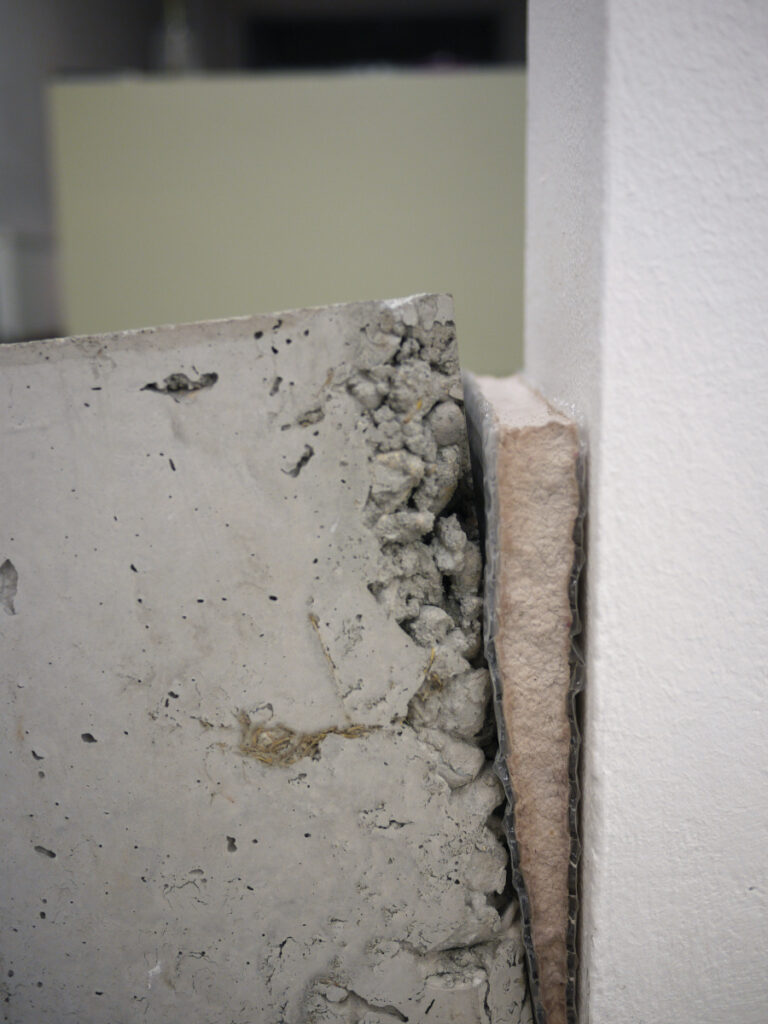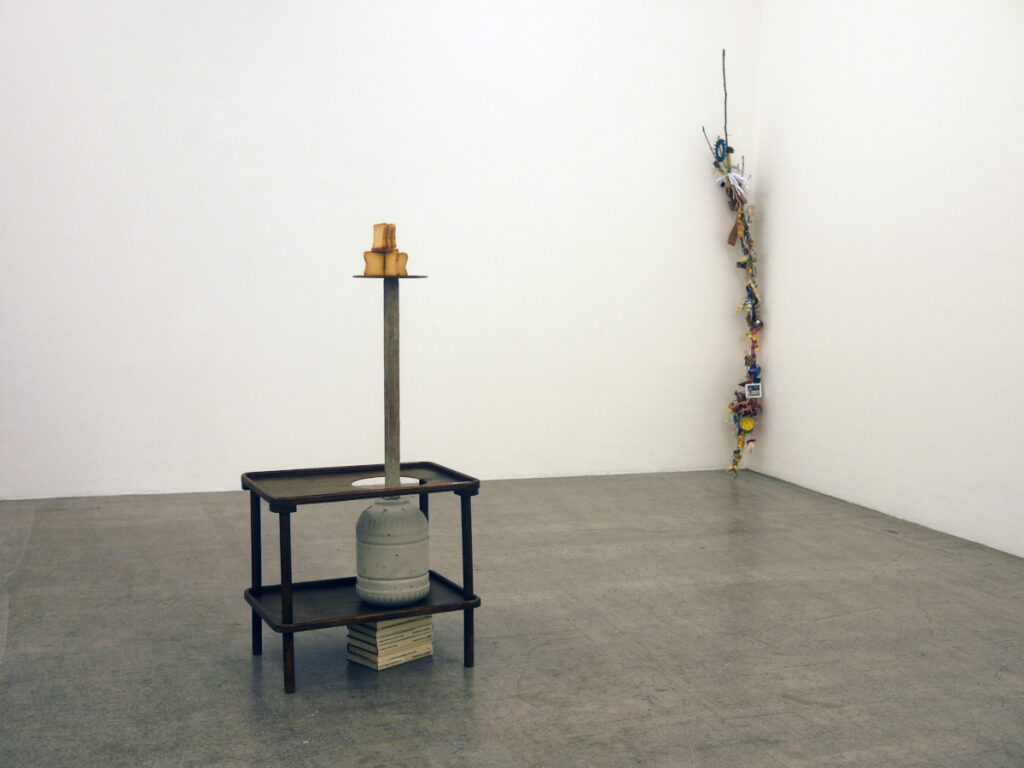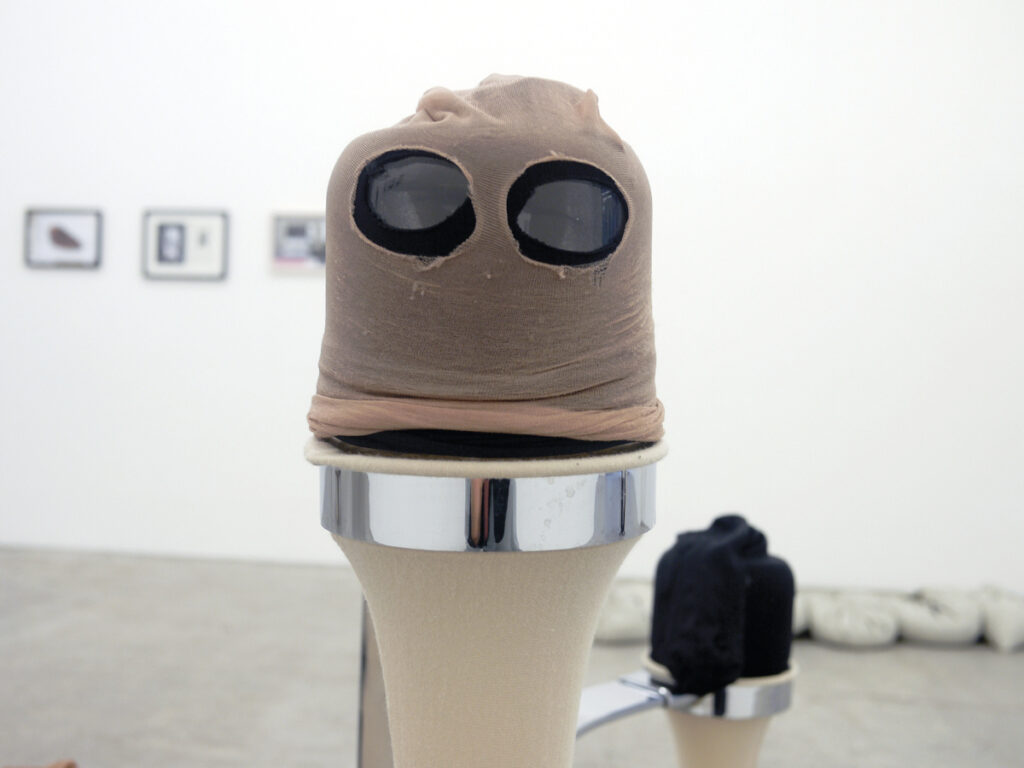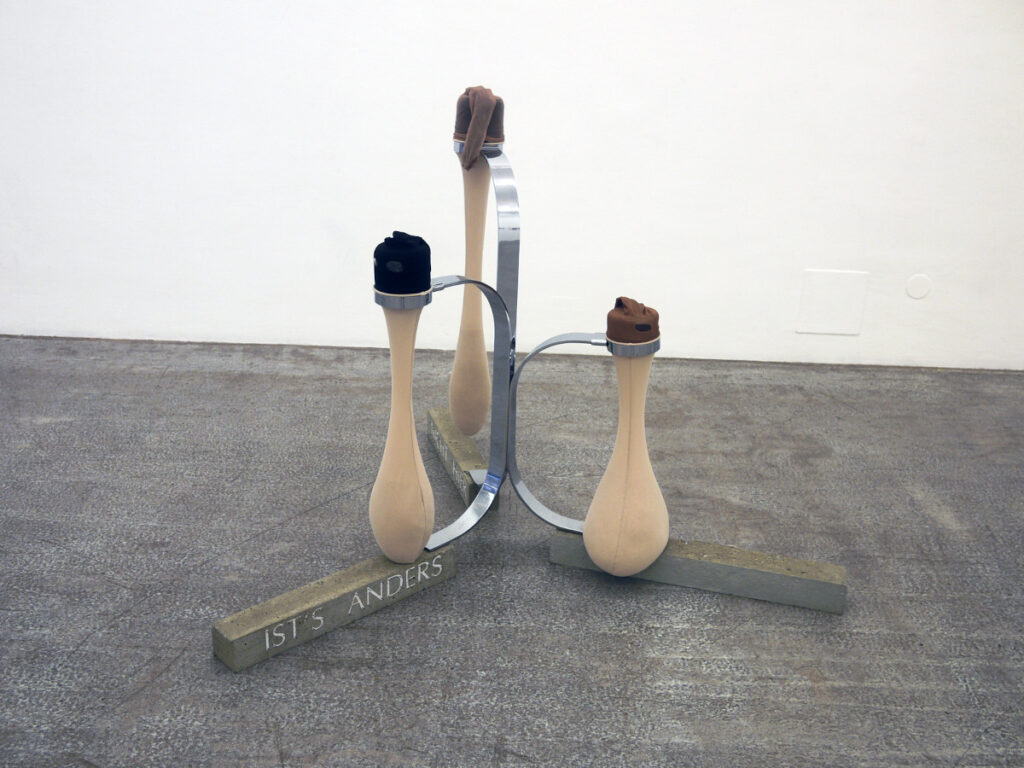
Faksimile der Schuldverschreibungen (Facsimiles of the certificates of Indebtedness) / 18.09. 06.11.2010 / Kerstin Engholm Galerie, Vienna
To the right extent we should always remember overwhelmingly experienced contradictions, in the best case the materiality of incompatibility can be understood as „an experience“. Ar artists not increasingly restrained by an excessive staging of their own creditworthiness? It is worthwhile, instead of dwindling strength, over time, to take the selfwill of the material as a benchmark and use that.

Keil (Spline) / 2010 / concrete, papermaché, bubble wrap, wall / 31 x 20 x 20 cm / Show: Faksimile der Schuldverschreibungen (Facsimiles of the certificates of indebtedness) / 18.09. 06.11.2010 / Kerstin Engholm Galerie, Vienna
A slightly sloping concrete column that is not too big, so it remains portable. It is preferably placed in rather exposed places close to a wall of the respective institution the room, meanwhile we rightly call that infrastructure. The gap between the column and the wall is filled with fresh, juicy papiermâché. In the course of the exhibition, the shrinkage and drying of the resulting wedge can be observed. The column resembles those built at the same time outside in a landscape of Lower Austria: to carry the engine part of a kind of memorial dedicated to the missing water mills (see elsewhere on this page). The talk of the nonplace, of the nomadic as of the provisional is replaced: here we will speak of the devastation, of the wear of strength and the excessive incorporation of any other kind of behavior, let me come back to here later.

Das Teetischchen (The small Tea Table) / 2010 / table, books, conrete, wood, zwieback / 56 x 127 x 37 cm / Show: Faksimile der Schuldverschreibungen (Facsimiles of the certificates of indebtedness) / 18.09. 06.11.2010 / Kerstin Engholm Galerie, Vienna
Despite all the words, one can not ignore the fact that a language is being developed through sculptures. Here The tea table, having been relieved of its mobile function at home. On the cast in concrete of a water tank balances an ensemble of Zwiebackscheiben. A model of, let’s say, formalistic monumentalism. The table must be supported to carry the load: a stack of books. Travel bug! Adventurous spirit! Once more. In the fullest sense: AN OASIS. The task was not the redisenfranchisement of the disinterested art connoisseurs, but rather the realization of uncompromising ideas of openings of the processes of art. Apparently reluctant needs are not waived: integration and autonomy. The movements of the longings for the other, which serves as a meaningmaker, whose always exotic and nostalgic impulses, are basic motives of the work. The imaginary achievement of the production of the Other is repeated, even its violent transference to realities that offer themselves, at least defenseless. Art is conquest. Who will be the historical subjects who produce the art of tomorrow? The tourists?
Mirage? Appears the body, where the text was, and now the readers and then those who write it again, the body and the places that update him, the objects that will remember him. The motif of incorporation was transformed into a gesture of liberation in Brazil in the 1920s the cannibal master of the balance between integration and awakened autonomy (Oswald de Andrade). Selective voracity as counterconquest; In case of doubt: asceticism, that is the method of autofiction in dialogue with the dead. Tirelessly the attitudes, ideas and rhetoric that form the body, to give a place, and a moment of their realization, in all polyphony. The nostalgia, the stranger and the promise are siblings. Hope is work ,says the hero, after time has gone crazy for him, and he spits out beyond his familiar civilization, who is working there… are the children playing. Senseless products that will not work. Development is double-edged, progress mostly instrumentalized. Do I still eat myself in front of the dogs?

NOT HERE / IS DIFFERENT / THAN THERE, these are the inscriptions in the concrete pedestals, which, like coordinates, give directions in this ensemble. The bags are more or less full, the deeper the fatter, so the pushing rule, which would be a simplification. What is a bond, I asked an economist, the voice to be heard, explanatory voice of another work in the room. By the way: The face as the good place, the beautiful capital of the worthwhile investment was to some extent battered already. (Sculpture is too: make a good figure.) Once again, the artist seeks to meet the point of exhaustion of art himself, hoping to touch the Other there. It was not about getting involved in “ornaments of the real economy”, but rather the tension between “adventurous speculative entrepreneurial spirit” and the “security need of saving frills” is part of a basic figure of human condition. The “bond” is chosen as a form of exchange between these spirits. But Stroj does not want to provide more than a “modest furnishing” of such a figure, in which such deliberately provisional lines of thought should be carried out. A yearning seems to pull him like us all – yearning to return to the immediate and reflected life. Where to speak of “realities”.
(Miras Ropot)

Dny Swobody (Tage der Freiheit) (Days of Freedom) / 2010 / metall, concrete, rice, nylons / 104 x dm 120 cm / Show: Faksimile der Schuldverschreibungen (Facsimiles of the certificates of indebtedness) / 18.09. 06.11.2010 / Kerstin Engholm Galerie, Vienna
The materiality of the work only seems to convey a nostalgic feeling about its body. Soothing, we do not seem to escape: the flesh. The collages catch the spirits: they are just photos. In the group of works “facsimile of the bonds” the artist tries to give also insights into a process of the clarification of own misunderstandings and “bad habits”. The defiant attitude by means of production, even artisanal production, to oppose the raging speculative spirit whioch was only conditionally justified. A kind of nostalgic fog hovers over the built worlds. Stroj continues to build and yet thinks aloud to himself: “Let foreigners let me become” we read in a ceramic lettering, and the artist seems to be limited: it can be arranged in the improvised worlds, but all too comfortably better Not.
Miras Ropot (Quotes Misha Stroj)
Faksimile der Schuldverschreibungen
„In loser Folge“ variiert Misha Stroj einen Gedankengang: es sei „die Schuldverschreibung als möglicherweise grundlegende ökonomische Figur zu entdecken, die Werk, wie Person, als Kunst bewegt“. Nun doch schon seit einer ganzen Weile verfeinert der Künstler sein methodisches „den Dingen eine Spur mehr als ihr bloss Schweigen Abtrotzen“, versucht seine beinahe Live-Improvisationen als nicht immer lautes Nachdenken im Raum zugänglicher zu machen. Spürbar bleibt ein Misstrauen gegenüber den in verschiedensten Formen auftauchenden Worten, eine gewisse feierliche Gleichgültigkeit greifbarer Welten gegenüber unermüdlichen Versuchen, diese zum Sprechen zu bringen. Neuerdings tauchen Stimmen auf inmitten der Stroj’schen Inszenierungen, Stimmen die vermeintlich einem Zugeständnis entspringen, gar einem Nachgeben: „weil am halben Wege raus aus der Kunst ich mich fragte: Was blieb zu tun? Dacht’ bloß laut es vor mich hin. (und meint ich somit die Antwort gefunden?)“ Nun lässt Stroj die Stimmen andere zu Wort kommen: angekündigt sei hier die Arbeit „Was ist ein Generationenvertrag? (Popcorn)“ in dem die Tochter des Künstlers das Interview eines gefragten Schauspielers als Sprechübung einstudiert: „Frauen finden reife Männer sexy“, lernt sie da zu sagen, bzw.: „Du musst aufhören, dir Sorgen zu machen und an dich glauben.“
Einmal mehr sucht der Künstler den Punkt einer Erschöpfung der Kunst selbst zu treffen, weil er hofft, dort das Andere derselben zu berühren. Es ginge nicht um ein sich Einlassen auf „Ornamente der Realwirtschaft“, vielmehr sei die Spannung zwischen „abenteuerlich spekulativem Unternehmensgeist“ und dem „Sicherheitsbedürfnis des Sparefrohs“ Teil einer Grundfigur menschlicher Befindlichkeit. Die „Schuldverschreibung“ ist gewählt als eine Form des Austausches zwischen diesen Geistern. Stroj will aber nicht mehr als eine „bescheidene Möblierung“ einer solchen Figur liefern, worin solch bewusst provisorischen Gedankengänge ausgeführt werden sollen. Eine Sehnsucht scheint ihn – wie uns alle – zu treiben: zum unmittelbaren und reflektierten Leben zurückzukehren. Dorthin wo man von „Wirklichkeiten“ zu sprechen pflegt.
Besonders der Galerieraum bietet sich an, bisher entwickelte Arbeitsweisen pointiert vorzuführen, der Ort an den Künstlerinnen regelmäßig wiederzukehren pflegen. Stroj scheint diesen Raum zu genießen. „Wo die Erwartungen am feinsten ausgearbeitet, dort lassen sich Freiheiten maßlos auskosten“. Wir werden sehen, ob dies gelingen mag. Mittlerweile sei die Einsicht gereift, dass im Sturm der Innovationssüchte die Stagnation (phasenweise Regression) eine revoltierende Haltung sei. Der Künstler besteht darauf „eine kaum spürbar andere Version“ seiner letzten Ausstellung in der Engholm Galerie zu zeigen, damals hatte es geheißen: „Versprechung machen, Versprechung sein?“ KünstlerIn sein empfindet Stroj zunehmend als „verhalten exzessive Inszenierung eigener Kreditwürdigkeit“. Das beschworene An-sich-Glauben bleibt schlussendlich durch jene Anderen gewährleistet, die an Einen glauben mögen. „Ich mag Eisbein mit Sauerkraut. Und Würstchen“, so die Stimme der oben erwähnten Arbeit.
In der Werkgruppe „Faksimile der Schuldverschreibungen“ versucht der Künstler auch Einblicke zu gewähren in einen Prozess der Klärung eigener Missverständnisse und „schlechter Gewohnheiten“. Die trotzige Haltung mittels Produktion, gar handwerklicher Fertigungen, dem tobenden Spekulationsgeist entgegenzutreten, sei nur bedingt zu rechtfertigen. Eine Art nostalgischer Nebel schwebt über den gebastelten Welten. Stroj bastelt weiter und denkt doch laut vor sich hin: „lies lass fremde mich mir werden“- lesen wir in einem Schriftzug aus Keramik, und bedingt scheint der Künstler dabei zu bleiben: es lässt sich einrichten in den improvisierten Welten, allzu gemütlich besser aber nicht.
Miras Ropot (Zitate Misha Stroj)















